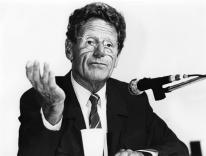Manhattan College, founded by the De La Salle Christian Brothers in 1853, is proud of its Catholic tradition. The chairman of its board of trustees, corporate executive Thomas D. O’Malley, has noted that it has a crucifix in every classroom, three churches, daily Mass, and much religious art gracing its campus in the Riverdale section of the Bronx. Two-thirds of the thirty-five hundred students are Catholic, he reports, and the graduation Mass is standing-room only. Every student must take a Catholic-studies course.
But of late the college administration is getting unwanted instruction from one of its religious-studies professors, Joseph Fahey, who says Manhattan College has violated Catholic social teaching by trying to deny its adjunct faculty the right to join a union. Fahey, who is chairman of the 250-member advocacy group Catholic Scholars for Worker Justice, has become a central figure in a union drive begun last October to organize the Manhattan College adjuncts.
As he told college President Brennan O’Donnell, authoritative Catholic teaching states clearly that workers have a right to organize. He elaborated on this when serving as chief witness for the New York State United Teachers union (NYSUT) in its dispute with the college before the National Labor Relations Board (NLRB). “Labor unions are an indispensable element of social life in Catholic teaching,” he testified, citing statements of the magisterium compiled in the Compendium of the Social Doctrine of the Church. “No one may deny the right to organize without attacking human dignity itself.”
Even as many Catholic institutions move to deepen their Catholic identity, they sidestep what the Catholic Scholars call “the right to free association that is rooted in the natural moral law and that serves as the cornerstone of Catholic social teaching on workers’ rights.” Nor do they seem worried that the scholars’ organization has called union-busting a mortal sin.
At a time when workers’ ability to organize is under renewed assault, church teachings on the rights of workers and the duties of unions toward the common good loom larger. But if the church doesn’t practice what it preaches, it would be hard to expect anyone to take these often-overlooked teachings seriously.
The U.S. Conference of Catholic Bishops has in fact affirmed that these teachings apply to Catholic institutions, primarily in two documents that aimed to improve the sometimes-bitter labor-management relations in Catholic hospitals. The first, “A Fair and Just Workplace: Principles and Practices for Catholic Health Care,” said in 1999 that hospital employees had the right under Catholic teaching to unionize. Management and labor officials signed on to that.
With tensions persisting, the bishops negotiated another agreement in 2009 with the Catholic Hospital Association, the AFL-CIO, and the Service Employees International Union. It reaffirmed the right of workers to organize and recommended a process for local agreements to be reached between labor and management.
Manhattan College is hardly the only Catholic institution that has tried to block unionizing efforts. But I have not seen another case that addressed the morality of that action so directly—with Fahey, leader of the Catholic Scholars group and director of the college’s labor-studies program, framing the issue for college officials in terms of obedience to Catholic teaching.
O’Donnell, the Manhattan College president, said he “struggled and wrestled” with the teachings involved before deciding to challenge the move to unionize the part-time adjunct faculty. “What we’re talking about is a massive body of thinking and interpretation that has all sorts of complexities,” he said. “It’s a tradition that recognizes that one-size-fits-all approaches are not always the best way to make decisions.” The Catholic tradition recognizes the struggle between “competing goods,” he said, adding, “prudential judgment is involved.”
I read O’Donnell a straightforward passage from the bishops’ 1999 document concerning Catholic hospital workers’ right to unionize:
The core of Catholic teaching in this area is that it is up to workers—not bishops, managers, union business agents, or management consultants—to exercise the right to decide through a fair and free process how they wish to be represented in the workplace. Workers may decide to be represented by a union or not to be represented. Catholic teaching respects their decision.
When I asked him if the bishops had failed to recognize the complexities in the Catholic tradition, he said he didn’t want to dispute the bishops’ statement.
O’Donnell said that with a tight budget, the college needed to watch its expenses carefully so that it could control tuition costs. Without that, he said, it couldn’t carry out its mission. The “good” threatened by unionization of his school’s adjuncts involved “our ability to teach our students in an atmosphere of institutional distinctiveness,” which he said the NLRB’s “potential intrusiveness” threatened.
This is the way many Catholic institutions have framed the debate—that federal labor regulations infringe on their First Amendment right to religious freedom. The church is not the first organization to invoke the First Amendment to fend off unionization: the Associated Press said its right to freedom of the press was undermined by having the NLRB certify a union for its workers, a gambit the Supreme Court rejected in 1937.
But government regulation of a religious organization’s labor practices turned out to be more complicated. The Supreme Court ruled in 1979 in NLRB v. Catholic Bishop of Chicago that church-operated schools teaching both religious and secular subjects are exempt from NLRB jurisdiction, which means they can’t be required to recognize an employee union. The Court cited an earlier ruling saying that religious authority “pervades” a religious school through its teachers, even in secular subjects (Lemon v. Kurtzman, 1971). For that reason, it said, the NLRB should not be able to regulate how religious schools manage their teachers.
Administrators for Catholic colleges, which can’t be “pervasively sectarian” if the schools are to qualify for federal aid, have to maneuver through this legal landscape. Being “too” Catholic could lead to loss of federal aid; not being “Catholic enough” could open the door to faculty unions, which the administrators fear would raise costs.
In the NLRB case concerning Manhattan College, Fahey played what so far is a decisive role. What proved so important wasn’t his testimony on Catholic social teaching, which had no bearing on the legal outcome. Rather, it was his testimony that the college’s required Catholic-studies course “is a process to study Catholic ethics or rituals or teaching, but not to make people Catholic. It is not designed to indoctrinate in any way.”
The acting regional NLRB director, Elbert Tellem, took this as evidence in his January 10 decision that Manhattan College was not a church-operated school in the sense that the Supreme Court defined one. Rejecting the college’s First Amendment claim, he found that the NLRB would not intrude on the school’s religious practice by recognizing an employee union. He ruled:
Where, as in the instant case, a school’s stated purpose does not involve the propagation of a religious faith, teachers are not required to adhere to or promote religious tenets, a religious order does not exercise control over hiring, firing, or day-to-day operations, and teachers are given academic freedom, this risk of entanglement is obviated.
That set the stage for workers to vote this spring on joining the union.
In its appeal, Manhattan College said the NLRB official had an outmoded, enforcement-minded, pre–Vatican II understanding of what it means to be Catholic and that he had ignored board chairman O’Malley’s testimony of how thoroughly Catholicism infuses the life of the campus. In any case, the college said, a government agency had no business deciding who is really Catholic.
The NLRB in Washington agreed to hear the appeal, which the Association of Catholic Colleges and Universities has backed. But whatever the outcome—one can imagine the conservative Catholic majority on the Supreme Court taking up the case—it has no bearing on the question of whether the college is conforming to church teaching. While the law offers a handy refuge to Catholic institutions looking to keep their workers from unionizing, Catholic teaching doesn’t. Any meaningful review of an institution’s Catholic identity should consider whether it puts church teaching into action in dealings with its workforce.
It should be said that under Catholic social teaching, unions have a duty to promote the common good and not just the narrow interests of their members. Unions that cite these teachings when it comes to management responsibility should also be willing to follow them.
When I asked about the unions’ responsibilities, Fahey said that they are expected to work cooperatively with employers and have a duty to avoid a confrontational approach to bargaining. Unions would violate the moral law if they promote their own good to the exclusion of others, he said.
I asked Fahey about a hypothetical case in which a faculty union at a Catholic high school presses the administration to eliminate the jobs of nonunion clerical staffers or not give them raises so there is money available to provide a raise for teachers. He said the union would be remiss in its duty, adding that in many cases, union-negotiated benefits extend to nonunion personnel.
I also asked about the choice of New York State United Teachers to represent the interests of adjunct faculty at a Catholic college, given that union’s staunch opposition to state funding for Catholic education and school vouchers. Fahey said that in the past the union was told it would be lobbied to change those policies. But it is hard to imagine the six-hundred-thousand-member NYSUT, a major political donor with much clout in the New York State Legislature, backtracking on a position it has long promoted. (Disclosure: I am a NYSUT member.)
On the other hand, I asked O’Donnell whether his board is pushing him to take an antiunion stance (since its chairman, O’Malley, battled unions at oil refineries his companies purchased). O’Donnell said that it was the administration’s call, supported by the board. He called it a difficult decision, but one he is comfortable with. “My conscience is clear on this,” he said.
It looks to me, though, as if Catholic colleges need to go through the process that hospitals are trying. Bishop William F. Murphy of the Diocese of Rockville Centre, New York, put it well in the foreword to “Respecting the Just Rights of Workers: Guidance and Options for Catholic Health Care and Unions,” the 2009 report on hospital labor disputes. “The pain and damage from past disputes is real,” he wrote. “But in our hearts we know the contentious status quo diminishes all of us—Catholic health care, labor, and the church.”
Related: Letters to the editor responding to this article
The Right to Unionize, by Eduardo Moisés Peñalver
Please email comments to [email protected] and join the conversation on our Facebook page.
Share
Previous Story
Second Collection
Next Story
‘Society Men’: An exchange


